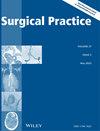Robotic surgical management of renal tumours with caval thrombosis: A comprehensive analysis and outcomes in a case series using minimally invasive approaches
Abstract
Introduction
Since the 1970s, the surgical treatment of renal tumors with caval thrombosis has been a complex challenge. The advent of robot-assisted nephrectomy with tumor thrombectomy has revolutionized this field. This case series aims to report the outcomes of an unselected population of Renal Cell Carcinoma (RCC) with complex caval thrombosis treated robotically at our center.
Methods
We established a database for RCC cases with inferior vena cava (IVC) thrombectomy, including five patients treated between October 2022 and October 2023. A notable aspect of our methodology was the incorporation of the AngioVac system for the management of a level IV thrombus facilitating a minimally invasive approach without the need for a thoracic approach.
Results
All patients underwent successful robotic surgery without conversion to open surgery. There were one pT3a, 3 pT3b and one pT3c tumors, 3 on the right side and 2 on the left, the upper level of the thrombus was II in one patient, III in 3 and IV in one. The average surgery duration was 414 ± 120.95 minutes, and the average blood loss was 400 ± 393, 70 cc. The mean IVC occlusion time was 20.6 ± 6.50 minutes. We did not observe any statistically significant differences between the preoperative hemoglobin values (12.14 ± 1.39) and the postoperative values (9.88 ± 0.96), nor between preoperative creatinine levels (2.00 ± 2.11) and postoperative levels (2.20 ± 2.00). The average length of hospital stay was 7 ± 2 days. We observed only 2 Clavien-Dindo grade 2 events. The follow-up period, updated for the last patient, is 12 months.
Conclusions
This case series demonstrates the viability and safety of robotic surgery in treating RCC with complex caval thrombosis. While the study is limited by the small number of cases, these results contribute to the growing body of evidence supporting robotic surgery in complex renal tumors.

 求助内容:
求助内容: 应助结果提醒方式:
应助结果提醒方式:


